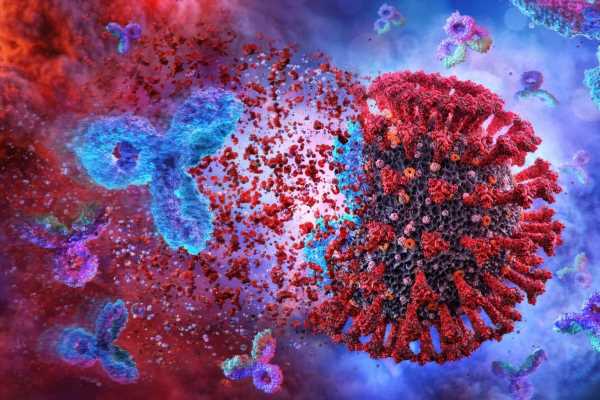A recent study published in PLOS ONE investigated whether antibodies enhance severe acute respiratory syndrome coronavirus-2 (SARS-CoV-2) infection.

In the early coronavirus disease 2019 (COVID-19) pandemic period, COVID-19 convalescent plasma (CCP) was recommended as a passive immunization therapy for patients with acute infection. As such, it was one of the few therapeutic options available initially; while the treatment produced positive results to some extent, its efficacy is poorly understood.
Clinical efficacy is determined by the neutralization antibody titers and resultant neutralization activity of the CCP unit. Previously, the authors of this study reported that quantifying antibodies directed at SARS-CoV-2 spike (S) protein’s receptor-binding domain (RBD) was a better proxy for SARS-CoV-2 neutralization.
Despite the promising results of CCP, it remains to be investigated if anti-S protein antibodies cause adverse events in CCP recipients; specifically, antibody-dependent enhancement (ADE) of infection that might enhance viral replication and cause subsequent infections. ADE possibility is high when SARS-CoV-2 reinfection or vaccine-breakthrough event occurs.
The study
The current study measured anti-SARS-CoV-2 S protein antibodies of the IgA, IgM, and IgG isotypes and assessed the role of ADE due to anti-S antibodies in COVID-19 infection. The researchers developed an infectivity assay based on retrovirus pseudotypes to evaluate neutralizing titers of CCP units in cells expressing only angiotensin-converting enzyme-2 (ACE2), the human receptor for SARS-CoV-2, or in combination with either Fc gamma receptor II (FcγRIIA) or Fc alpha receptor (FcαR).
Serum and plasma samples were obtained from 90 CCP donors. The half-maximal inhibitory concentration (IC50) values ranged from <8 – 581.4, highlighting the varying degrees of neutralization responses. Moreover, total Ig titers and anti-nucleocapsid (anti-N) IgG antibodies varied among the CCP donors.
The authors noted variations in total anti-S protein responses among the donors, and a correlation of anti-RBD and anti-S protein antibodies (of IgG isotype) to the neutralization potential of CCP. Between April–August 2020, 48 patients received CCP therapy; of these, four were excluded because they were hospitalized with a non-COVID-19 life-threatening illness. Mechanical ventilation and intubation were used as detrimental markers assessing disease progression, and sustained respiratory improvement was used as a recovery marker.
Most patients showed sustained respiratory improvement at an average of 7.9 days post-admission. Seven patients (16%) died post-CCP transfusion while 37 were alive. In the early period of the study, patients were admitted before the availability of CCP units. They were on average provided with CCP nine days after admission, and in the later weeks, patients were transfused with plasma within two days.
The antibodies transferred from the CCP donors were assessed to ascertain if they were non-detrimental to recipients. To this end, plasma and serum samples of the 90 donors were assayed for ADE of infection of retroviral pseudotypes. They assessed the neutralization of murine leukemia virus (MLV) particles pseudotyped with the S protein of SARS-CoV-2 in cells that expressed ACE2 alone or with Fc receptors (ACE2 and FcαR-, and ACE2 and FcγRIIA-expressing cells). An increase in IC50 values in the presence of Fc receptors was considered ADE of pseudovirions. No differences were observed in individual samples' IC50 values, indicating that S-protein mediated ADE was absent at least when Fc receptors were present. Moreover, IgA, IgM, and IgA titers were quantified using an in-house antibody-capture enzyme-linked immunosorbent assay (ELISA). Titers of anti-S IgG antibodies were higher than that of IgM or IgA subtypes, and IgA and IgM titers did not differ significantly from each other.
Conclusions
The authors noted the absence of Fc receptor-mediated ADE of SARS-CoV-2 infection during the use of polyclonal antibodies from CCP donors. The neutralizing ability of antibodies from convalescents varied from one individual to other. Most antibodies against the S protein were of IgG class with lower IgM and IgA subtypes. Given the low titers of anti-S IgM and IgA antibodies, these were not found to enhance SARS-CoV-2 infection through their respective Fc receptors. However, ADE of SARS-CoV-2 infection may occur in vivo through a different mechanism.
Moreover, the samples were collected before any SARS-CoV-2 variant of concern (VOC) emerged, and it is possible that individuals with prior non-VOC infection could experience ADE if they get reinfected with a VOC. In conclusion, the present work reported the safety of antibody-based therapies (vaccines and CCP) and showed that using anti-S protein antibodies does not enhance SARS-CoV-2 infection.
- Clark NM, Janaka SK, Hartman W, Stramer S, Goodhue E, et al. (2022). Anti-SARS-CoV-2 IgG and IgA antibodies in COVID-19 convalescent plasma do not enhance viral infection. PLOS ONE. doi: https://doi.org/10.1371/journal.pone.0257930 https://journals.plos.org/plosone/article?id=10.1371/journal.pone.0257930
Posted in: Medical Research News | Medical Condition News | Disease/Infection News | Healthcare News
Tags: ACE2, Angiotensin, Antibodies, Antibody, Assay, Convalescent Plasma, Coronavirus, Coronavirus Disease COVID-19, covid-19, Efficacy, Enzyme, Fc receptor, Immunization, in vivo, Leukemia, Pandemic, Protein, Receptor, Respiratory, Retrovirus, SARS, SARS-CoV-2, Severe Acute Respiratory, Severe Acute Respiratory Syndrome, Syndrome, Vaccine, Virus

Written by
Tarun Sai Lomte
Tarun is a writer based in Hyderabad, India. He has a Master’s degree in Biotechnology from the University of Hyderabad and is enthusiastic about scientific research. He enjoys reading research papers and literature reviews and is passionate about writing.
Source: Read Full Article
